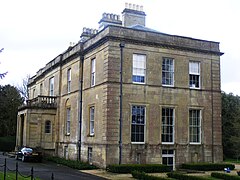Dinder House
| Dinder House | |
|---|---|
 |
|
| General information | |
| Location | Dinder, Somerset, England |
| Construction started | 1799 |
| Completed | 1801 |
| Client | Rev William Somerville |
Dinder House, is a 12,954 square feet (1,203.5 m2) Grade II Regency listed building in the small village of Dinder, in the civil parish of St Cuthbert Out in Somerset. It was built between 1799 and 1801 by the Rev William Somerville on the site of a former manor house. Further wings were added later, and the house remained as the seat of the Somerville family until the late twentieth century.
The estate had come into the Somerville family on the marriage of an heiress of the Hickes family to George Somerville (d. 1776), father of the William Somerville who erected the new house in 1801. On the death of William's widow, the estate passed to his nephew, James Somerville Fownes, who adopted the surname Somerville, to save its connection with the house. The last Somerville resident of the house was Admiral of the Fleet Sir James Somerville, who was in charge of the British force that sank the French fleet at Mers-el-Kébir, near Oran, Algeria, on 3 July 1940. After World War II, Somerville, who was made Lord Lieutenant of Somerset in August 1946, lived in the house, dying there on 19 March 1949. He was buried at the Church of St Michael and All Angels Church at Dinder.
Dinder House passed out of the Somerville family and is now owned by the Mycock family, who bought it in 2002. Under their ownership the interior has been given a makeover, giving it a contemporary feel which combines the old with the new.
Dinder House is a small country house constructed of ashlar stone with a hipped slate roof and ashlar chimney stacks. The original house was constructed between 1799 and 1801 and consisted of only the centre part of the building. The outer bays were added around 1850 by Vulliamy, and a further single-storey addition to the north dates from 1929. The house is linear in plan with bays arranged symmetrically 1:1:3:1:1, with the side bays slightly stepped back. The house has two storeys, an attic and a basement. Interior features include an oval shaped vestible with curved panelled doors, a marble fireplace, decorated plaster ceilings and a geometrical stone cantilever staircase, with a mahogany handrail and wrought iron balustrading.
...
Wikipedia
